Operation Re-store World - published in Mediamatic Magazine Vol. 8#1 (1994)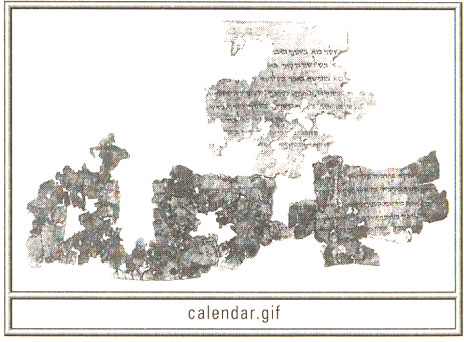
These little fellows are usually bored stiff by it, but the last few years they are seeing more and more things which make them giggle.They see how in Australia an embryo, and somewhere else
Glenn Gould records are launched into space. With great hilarity, they see how a block of concrete with the best books 'of all time' is sunk to the bottom of the Pacific. They see Leonardo da Vinci's Last Supper disappear into the face of the earth, followed by Jeff Koons' Ushering in Banality. They see howsomewhere a 'delegate' slips a box containing floppies and discs full of world data into a cranny in the cliffs. They see how 'representative species and remarkable excrescences' are being entrenched into secret bunkers. (An old woman with a dried-out cactus in her hand is sent away to the sound of scornful laughter. An Indian, an AIDS patient and a mountain gorilla are resisting recruitment – to no avail, they are on the List.) The little green men are splitting their sides with amusement...
Anticipating the future, all these insane scenarios are now being devised or implemented. If you are not careful, you will be involved as a supernumerary or undertaker of a terminal culture whose only remaining concern is the polishing, safeguarding and cataloguing of its heritage. Convinced as it is of its universal importance, this culture shows generosity by 'preparing' itself as a heritage, and, as such, saving itself from Destruction. Future generations, or 'visitors from outside', will be offered a fully comprehensive model patrimony, preferably on a scale of 1 to 1. The motto is: save as much as can be saved, not for ourselves, but for posterity. The hour and the moment of the Lists, of the inventories and maniacal enumerations, has arrived. They are churning out one `checklist' after another, as if culture has become demented and needs a constant reminder. Who or whatsoever is on the list can kiss the world goodbye.
Another example of what the little green men see, but which has not en mentioned yet: how in France someone from the World Heritage Committee is bolting a World Heritage plaque and emblem to the Cave of Lascaux, and how others are performing similarly foolish activities at 409 other sites included in The World Heritage List. The World Heritage List is real: The World Heritage Committee, part of UNESCO, has been working on it since 1972, with the objective to define the world-wide natural and cultural heritage and to draw up a list of sites and monuments considered to be of such exceptional interest and such universal value that their protection is the responsibility of all mankind.
Operation Re-store World - published in Mediamatic Magazine Vol. 8#1 (1994)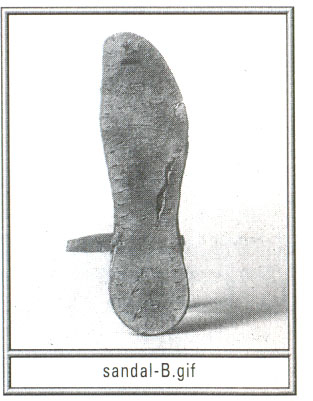
1 I found the UNESCO World Heritage files, from which I quote, on Internet when I was travelling around the world from the Digital City (menu Central Station) and chose icomos under International Organisations. The Operational Guidelines and the comprehensive World Heritage List are included there.
Suddenly we are personally lumbered with the Pyramids of Egypt, the Grand Canyon in Colorado, with the Taj Mahal, the Machu Pichu of the Incas. With the Notre Dame, Aachen Cathedral, with the Vatican City, the town of Potosi in Bolivia, with the city centre of Florence, the Chinese Wall and the Tyr in the Lebanon, with all the Baroque churches in the Philippines, and, of all things, with the Statue of Liberty in New York... It does not matter at all whether Amsterdam (including that ancient wall they have just unearthed), our birthplace, all the McDonalds, Sarajevo, and all of Belgium go to ruin. They are not on the List.
The World Heritage's World
The World Heritage project is a perfect example of a form of conservation whereby Nations or government bodies appoint themselves as protectors and saviours of culture and nature, under the pretext of 'urgent necessity'. Save the world! They are always rubbing in 'our' wish for a heritage, with dubious supporting terms such as 'loyalty', guilt' and 'glory'. But the preparation of a heritage can also be construed as the testimonial staging of death: the organised fixation on the Legacy, which only after death can be revealed in its full splendour, is in reality an incitement for collective euthanasia.
The 123 countries which have endorsed the Convention for the Protection of the World Cultural and Natural Heritage can nominate sites and monuments. Subsequently, the Committee, which is made up of 21 specialists, decides whether the objects nominated can really be regarded as the 'cultural and natural wonders' which are part of The World Heritage. Architectural monuments are eligible, and sculptures, paintings, cave paintings and, whether they are inhabited or not, historic regions or city centres and traditional villages; but moreover, contemporary architecture and natural monuments or sites which meet specific physical and biological criteria. Then there is the List of the World Heritage in Danger, on which a site or monument can be placed if it is seriously endangered, for example, by natural decay or war. (You're dying, we can't help you, but perhaps your house is on the List.)
In his will, the testator can pass the most whimsical verdicts and make the most unrealistic demands. Thus we read in the Operational Guidelines of the World Heritage project that a monument nominated not only has to be materially authentic, but also must be a unique artistic achievement, a masterpiece of the creative genius; (...) have exerted great influence, over a span of time or within a cultural area of the world, on developments in architecture, monumental arts or town planning and landscaping; or bear a unique or at least exceptional testimony to a civilisation which has disappeared... 'Natural properties' are of universal importance as superlative natural phenomena, formations or features, for instance, outstanding examples of the most important ecosystems, areas of exceptional natural beauty or exceptional combinations of natural and cultural elements...
Operation Re-store World - published in Mediamatic Magazine Vol. 8#1 (1994)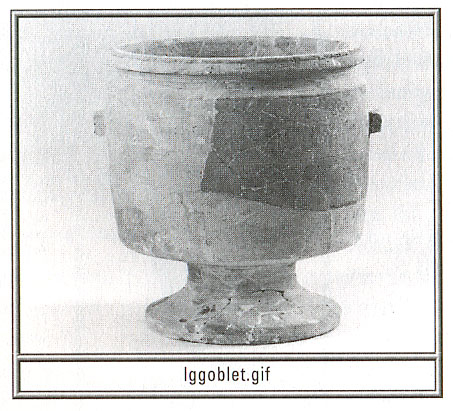
And so the World Heritage project proves to be an old-fashioned museum, with standards and criteria dating from the nineteenth century. In its 'collection' there is only room for 'authentic masterpieces', which in turn have to be as intact and complete as possible: for example, an 'ice age' area would be expected to include the snow field, the glacier itself and examples of cutting patterns, deposition and colonisation (striations, moraines, pioneer stages of plant succession, etc.). The Guidelines stipulate that monuments or sites which are too badly damaged will not be considered, that `doubles' must be avoided, that a balance between cultural and natural heritage must be ensured. The List has no formal limit - as with a real museum, masterpieces can always be discovered and fitted seamlessly into the collection, which is as infinite as time. As in a real museum, the `objects' admitted to the collection are protected by an appropriate 'buffer zone':// an area surrounding the property which has restrictions placed on its use to give an added layer of protection... The World Heritage objects are subsequently identified by the specially designed `World Heritage Emblem' placed in such a way that it does not visually impair the property in question). In order to inform and educate the public, they are setting up the production of plaques to commemorate the inclusion of properties in the World Heritage List. These plaques are designed to inform the public of the country concerned and foreign visitors, that the site visited has a particular value which has been recognised by the international community. In other words, the site is exceptional, of interest not only to one nation, but also to the whole world. However, these plaques have an additional function which is to inform the general public about the World Heritage concept and the World Heritage List. (At last it becomes clear that 'We the World' are ruling the world. There are no minorities, or they have no culture, they belong to 'Us the World'.) Like a museum, the World Heritage wants to present itself as a coherent set-up, in which the 'works' fit into the order of an evolutionary world history, whose moments of truth they reflect. The World Heritage wipes the floor with My World Heritage, with Your World Heritage, with Their World Heritage. But because of the way in which it emphasises itself as a concept, it is both a nineteenth century project and a hypermodern one. It's a World Heritage's world.//
History as a Mickey Mouse Story
The World Heritage as a touristic fun route - it would have been a dream-come-true for Baedeker, the pioneer of the modern travel guide and inventor of the 'star system' for the classification of culture - is only one of the projects for the 'museumisation' of the world. Not only the past, but also the present and 'anticipating' the future, are involved in the cultivation of a maximally intact and complete 'exemplary' heritage. Care, preservation and protection: things become monuments, nature becomes reserve, knowledge becomes information and data, people and forms of life become models or examples. Issues are piling up, archives are jam-packed, data banks are multiplying. It is not only a matter of conservation and restoration of culture and nature, in the form of (open air) museums, zoos, wild-life reserves, reservations for tribes or races, protected nature reserves, monument care, organised commemoration of events or persons, etc... But also technology and industry are eligible for monumentalisation: The International Committee for the Conservation of the Industrial Heritage TICCIH, set up in Sweden in 1978, promotes international collaboration in the field of conservation, research, documentation and presentation of our industrial heritage'. This includes the physical remains of the industrial past, such as landscapes, sites, structures, plants, equipment, products and other fixtures and fittings, as well as its documentation, consisting of both verbal and graphic material, and records of the memories and opinions of the men and women who have been involved.
2 TICCIH files can also be found under icomos. At the same time, everyday life is being documented and collected on a large scale, as an action parallel to life. In Sweden, a national project, which started in the 1970s under the name of SAMDOK, was aimed at collecting and registering objects in everyday household use in a structural manner, simultaneous with their use, to leave posterity with a maximally accurate, differentiated and representative picture of life in Sweden.
3 On the subject of SAMDOK, read, for example, Klaus Weschenfelder's article entitled 'Museale Gegenwartsdokumentation – Vorauseilende Archivierung', in: Zeitphänomen Musealisierung, Wolfgang Zacharias (pub), pp. 180-188. But outside Sweden, too, cities have built up archives in which anything considered to be of interest for the future is daily being put on file.
Operation Re-store World - published in Mediamatic Magazine Vol. 8#1 (1994)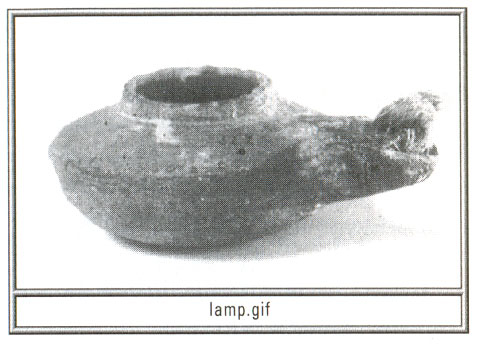
We are running ahead of the future, things of today are being made 'museum-ready' to keep the heritage 'up to date', or being preserved for later, for example, in the form of in-vitro conservation and gene banks. And then there are the astonishing projects which, staged on a grand scale, reconstruct and act out the present and/or the past. The eco-greenhouse Biosphere II, in Arizona, shows on a small scale what it was like when everything was still biologically 'in order'. When the End of Time comes, selective groups of people will be allowed to survive in similar greenhouses on Mars. The recent dramatic developments around Biosphere II illustrate unambiguously the fusion of science, fiction and entertainment: two former inmates threw open the air locks of the Greenhouse to save the new, 'second generation' inhabitants from potential suffocation. And the financier of Biosphere, billionaire Edward Bass (who is also the major stockholder of the Disneyland consortium!), ordered federal agents to occupy the premises, accusing the original management of financial and scientific mismanagement.
The planned theme park Disney's America will act out America's history in six episodes, one of which deals with the annihilation of the original population. (In America, opponents of this project claim that it will turn history into a Mickey Mouse story. Its advocates point to the jobs it would create. Imagine that jobless Indians might perhaps let themselves be annihilated once again...) In the recently opened history park Archeon (Live three billion years in one day) in Alphen on the Rhine (The Netherlands), the world begins again with a big bang. The 'inhabitants' (Even the inhabitants are real) are constantly performing `authentic' activities from all periods. (A fun but dangerous game: imagine, if the locals in Amsterdam were forced to display 'typically Amsterdam' behaviour for the tourists, to hang around at pavement cafés or pretend to be squatters... But are they not doing that already?) In the World Heritage project as well as in all these crazy amusement parks, the pursuit or protection of authenticity culminates precisely in complete artificiality. These are worlds, hindsight-utopias, where everything can be forgotten in the whirl of the spectacle. But perhaps it is precisely there, and because of that, that people can be the unashamed children of their time.
Conservation as a Political Strategy
The maniacal preservation, 'rewinding' and reconstruction of history is pathetic and ridiculous as well as treacherous and disturbing. Pathetic and ridiculous because it is a futile enterprise which accomplishes exactly the opposite of what it aims for: everything declared to be 'world heritage' is being declared offside. Treacherous and disturbing because it might actually be the implementation of a political strategy, which stupefies us and carries us off into an amnesic delirium, or into a terrible tautological yawn. The conservation project manages to present itself as logical, as benevolent and 'good', even as necessary. Everything and everyone is dragged into it as a matter of course. But what appears to be willingly could easily turn out to be unwillingly. Although it is presented to us as a natural and universal yearning, this obsessive preservation, restoration and reconstruction of things, this museum treatment of the world, would seem specific to our time and specific to Western culture. There was a time when people only preserved what still had a direct and living connection with the present. Everything else could be forgotten or destroyed. It was a good way of tidying up and explains partly why in bygone days people dealt so 'carelessly' with precious 'monumental' matter – and still do, in other cultures or what is left of them. They never deliberately 'made' history (or the future), but if the present so required they had no qualms about demolishing things or 'recycling' them and using them for other purposes. The past could live on and be preserved in a symbolic, physically often invisible, way, or could be there unobtrusively or simply stop playing a role of significance.
What began as collecting and exhibiting material references of identification for a new bourgeois society in search of a documented past, has degenerated into an obsessive tendency to accumulate and dig up anything and everything. Historical consciousness adrift: not only the past, but also the present and future have become effects or scenarios of the museum, which has spread its wings and nestled in life itself. (Even though it actually used to be an ideal that life would seep into the museum, the order of the museum is now governing life.)
Operation Re-store World - published in Mediamatic Magazine Vol. 8#1 (1994)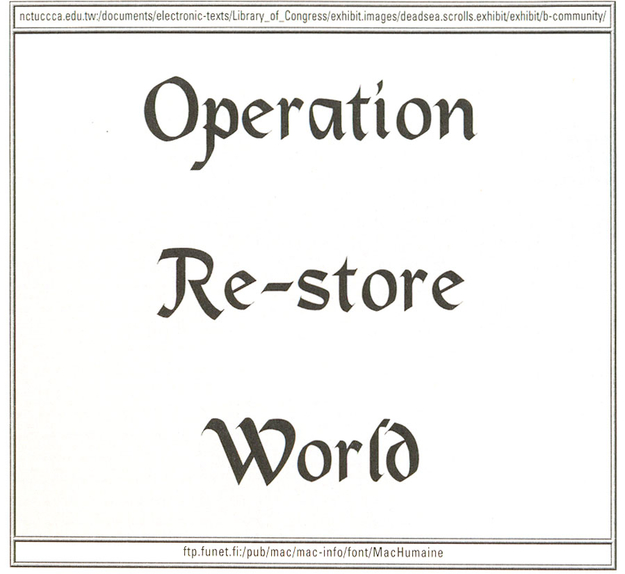
The refusal to destroy (or to let others destroy) is typical of our time and is an attempt to compensate for the unrelenting machine of destruction which drives the philosophy of progress. At the same time, this philosophy produces the 'past' it needs to present itself as new, as progress. In that sense, conservation is a political strategy designed for the management and monitoring of the present and the preparation of the future. In this respect, it is one of the great 20th-century industrial activities, and as with production and information it is subjected to 'overload', to hypertrophy, to accumulation and excess. (With paranoid institutions such as the CIA, or with other large concerns, this surveillance and monitoring function of storage is crystal-clear. The CIA make daily satellite photos of the world, and, in their World Book of Facts, they meticulously keep track of the situation and current events in every country of the world. Rumour has it that they also collect all kinds of literary scenarios and plots, just to be prepared for anything... A thriller might become `real' some day. Multinationals, in turn, often gather as many data on other companies as they can, also to prevent any `surprises'.)
Stand-In
With the mushroom development of the electronic memory, the scope of storage is expanding indefinitely. Data banks are being created for every imaginable aspect of life, and age-old, dusty archives are being transferred to the most modern information systems. The Archivo General de Indias in Seville harbours hundreds of thousands of historical sources, in the form of decrees, instructions, letters, regulations, case records, maps, petitions from Indian chiefs, etc., which refer to the historical ties between Spain and its former colonies in Latin America. The whole archive is now being digitalised. The manuscripts are being recorded on interactive, optical video disc, not only to protect the original collection (to preserve the past for posterity – the present is once again discarded), but also to increase their accessibility for the researcher: the documents, discoloured by time, can be 'cleansed' on the screen via the computer (stains can be removed, creased smoothed out, colours changed, letters enlarged or reduced, etc...). In a way, a 'contaminated' and guilt-laden episode of history is being relieved of its blood, sweat and tears, and being given a false air of innocence. In the unbearable lightness of the realm of data, things are being relieved of their stoutness and weightiness: as `bits' and `bytes' they all look the same. It is not about whether the originals speak the truth, but about their disappearance into a retouchable 'image': the act of copying makes the originals artificial, too. At the same time, the `real thing', having become inaccessible, is entrenched in secrecy for fear that it will be touched by life, so that its existence becomes insignificant. (Culture loses itself in its `stand-in' version. It is like the copy that has been made of the Cave of Lascaux to protect the original and, in the centre of Florence, age-old sculptures being replaced by exact replicas. Is it life or is it memorex? More and more often we will be kept in the dark about the authenticity of things.)
The World Heritage, too, has sealed its own fate of disappearance by evaporating into the digital universe. One of the projects of World Heritage is Patrimoine 2001, or Heritage 2001. The project 2001 has the objective of a bank of images of all of the heritage of mankind, UNESCO Director-General Federico Mayor told the launching ceremony.
Commissioned by UNESCO, photographers take photos of The World Heritage. The photographs as well as old footage are subsequently digitalised and stored on CD-ROMs, which in turn can be manipulated via the computer. This visual information will unite aesthetic gesture with the force of documentary, or, Imagination and Reality. Sites and monuments, native populations, immense natural reserves and parks, extraordinary animals: researchers and scientists are working to safeguard these endangered treasures. The techniques used to do so... The monuments, etc., have of course mainly been 'photo models' for many years now. But after Heritage 2001 they might as well be blown up. They are data, so they exist, will be enough for the data tourists of the 21st century. One more step into the era of technological reproducibility: things do not lose their aura, but the auras lose their things.
The Ancient Greeks used to practice a form of memory art whereby they stored everything they wanted to remember in an individually defined mental complex of places and images. For example, they memorised an imaginary building, including rooms, niches, columns, corridors, etc., and then `furnished' it with their own chosen 'eloquent' images reflecting the facts, texts or thoughts they found worth remembering. Within their memory buildings, whose structure they knew through and through, they opened a specific reminder' room, where the image stored stirred up the 'knowledge' desired. Never will we be able to fathom the secret of this fantastic `artificial memory' to the full. Not only because it is too far removed from our way of thinking, but also because it is foreign to our nature. Having been extrapolated to a collective level, our 'artificial memory' has been delegated to the outside world and has become fundamentally different in nature: it is perhaps most like an uncontrolled growth of images without places, or the other way around with the same implication, like an empty building, a labyrinth of blind spots.
Perhaps our late-20th-century memory is not designed to remember, but rather, designed to forget. How ironic this sounds in an era which is totally committed to the preservation and storage of anything and everything, for the Future and for Posterity. But witness World Heritage, nothing can be saved. This delirious anticipation and retrospection of matters and time has already foundered in a fatal paradox. The Future is Now and We are Posterity, or Visitors from Outside, tourists in a 'museumised' universe. Only for those who do not recognise it, will this be catastrophic. They will be buried alive alongside The World Heritage, as it was once customary to bury the dead together with their belongings. The 'survivors', next of kin, look bemused, bewildered, amused or bored, with the eye of a tourist or a newcomer, at all that frozen matter, at all that silly fuss, at all those uninformative data. They need not remember any of it (because they never knew anything about it). Noah's Ark has sunk. Meanwhile, we can behave as the public, as extras, or can (re)invent everything again...
And the little green men? They almost died of laughter when they saw how the embryo was split in two by Glenn Gould...
translation MARION OLIVIER / GAY WYLIE